
To write an excellent college-level history paper, you’ll need a structure that will help you organize your facts and ideas.
In this guide, first I’ll give you three effective ways to organize your historical essay.
And then I’ll show you how to further outline your larger sections in case you have to write one of those bigger papers.
As a result, you’ll be able to:
- Organize your thoughts
- Get ideas out of your head quickly
- Write a well-organized essay without getting stuck
Let’s dive right in!
Let’s Pick Our Historical Subject and Setting
To have a productive guide, we need our subject (the What) and the setting (the When) to use throughout the techniques and examples.
Let’s pick our subject and setting.
Subject
The antagonism between the United States and the United Kingdom in the quest for petroleum in the Middle East.
Middle Eastern oil was a big factor in the early 20th century, and the two countries have quite a history of rivalry in the quest for this precious resource.
Setting
This rivalry escalated between World War I and World War II.
Oil was especially important in the two world wars when war machines began to play a crucial role in warfare. It was also important in between the wars when the motor car industry exploded.
Let’s write out our full thesis (main point) so that we know what exactly we’re discussing in this essay we want to structure.
Our Sample Thesis
“The antagonism between the United States and the United Kingdom in the quest for petroleum in the Middle East escalated between World War I and World War II.”
Now that we know what this history paper will be about, let’s look at three very effective ways to structure such an essay.
1. Structure Your Essay Chronologically
A chronological structure is the most intuitive way to organize a historical essay because in it you simply proceed from earlier to later events as they happened in history.
History books are usually organized this way. And it’s a fine way to structure your paper. It is also a pretty simple and straightforward way.
Our structure for this essay about petroleum would look something like this:
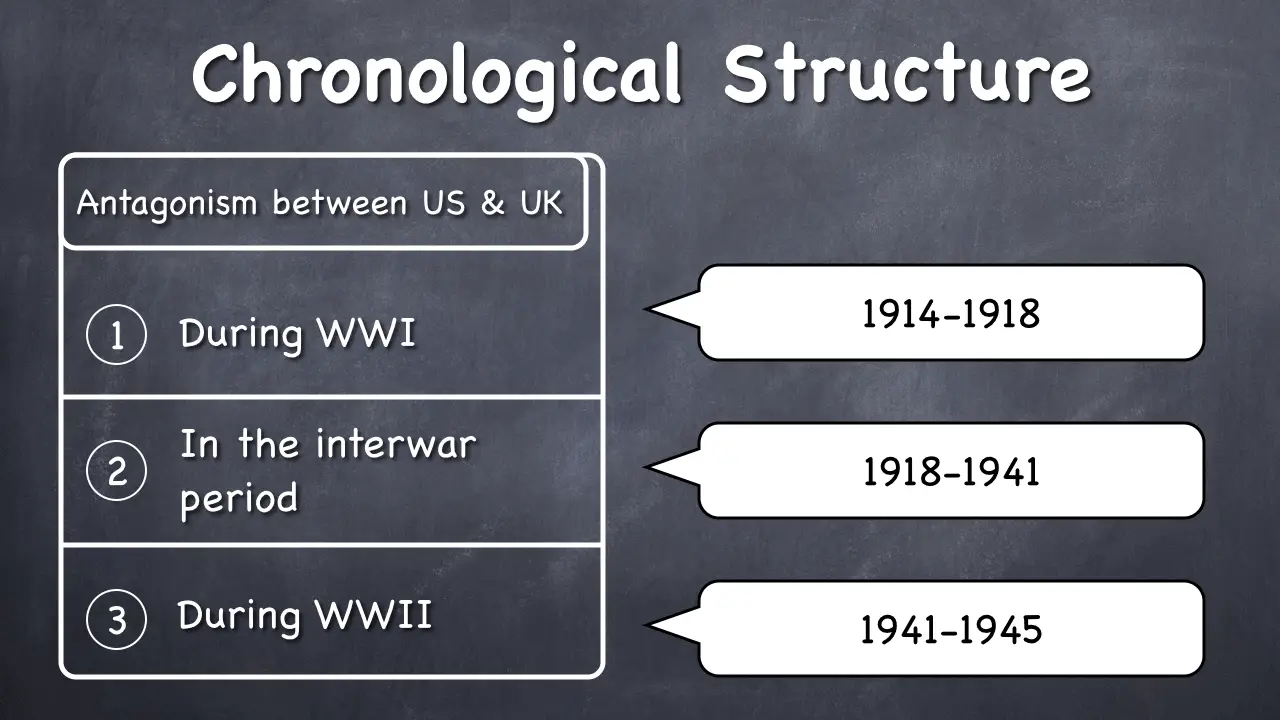
By the way, I usually choose to divide my essays into three main sections. Three is a very practical number when it comes to writing essays.
Besides, number three works very well for our example because we have three shorter periods – during WWI, in between the wars, and during WWII.
But you can use three sections with any subject and setting. This means you will have three supporting ideas for your main point.
You’ll see how easy it is to do as you read the rest of the guide.
What Happens In Each Section
I’ll give you several great ideas on how to structure each of your sections later in the guide. But for now, you can see the clear focus of each section.
Each one is devoted to a definite time period. You just need to make sure that you stick to what belongs in each section as you write it.
As you write your first section, make sure you focus only on what happened between the US and the UK during WWI, or between the years of 1914 and 1918.
This approach gives you a clear direction. Once you’re done with this period, proceed to the next. And then do the final section where you focus only on the period between 1941 and 1945.
Let’s move on to the next way to structure a historical essay.
2. Structure Your Essay Thematically
No matter what historical subject you write about, your essay will have certain themes. For example, an essay about war can include the themes of warfare strategy, financing of the military operations, or the treatment of civilians.
If you have a good idea of your themes, then maybe arranging your essay thematically is the right approach for your paper.
In our example, since petroleum played such an important role in the early 20th century, several themes come to mind:
- We can discuss why the demand for oil increased in each country or situation.
- We can talk about the scarcity of oil and why it was hard to come by at the time.
- And we can discuss the actual process of rivalry or quest for oil.
Here is what our structure would look like:
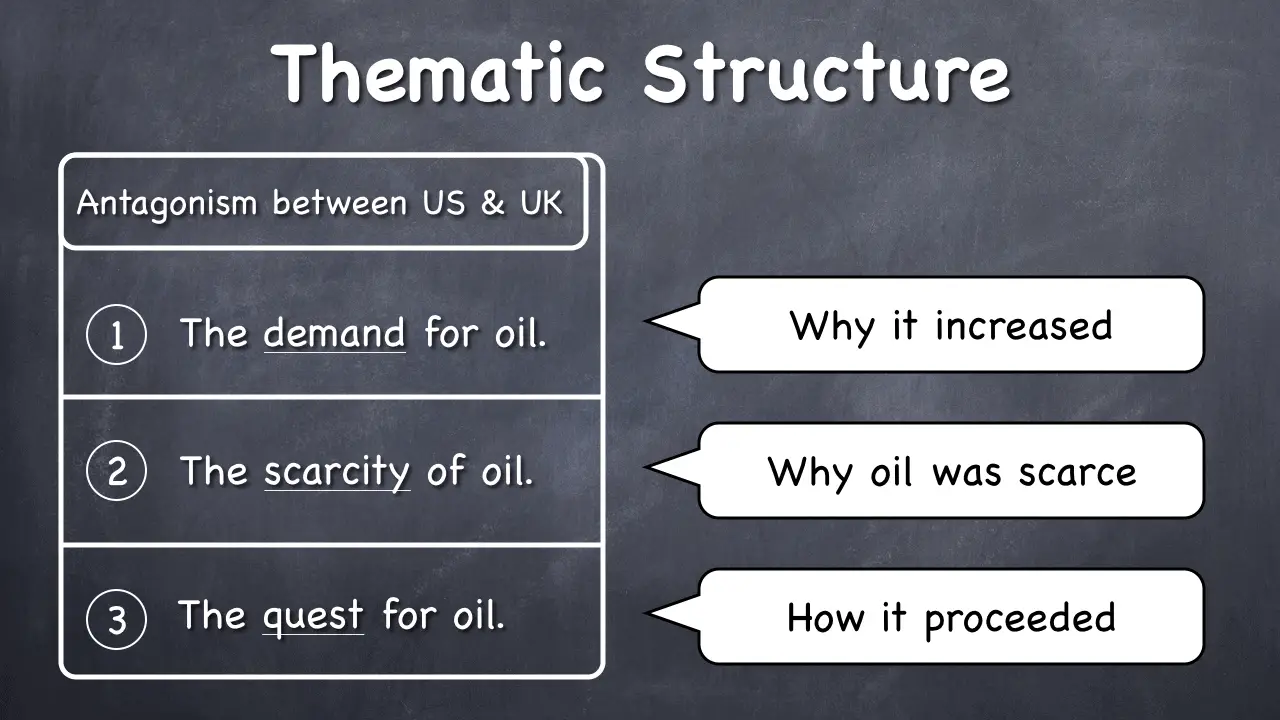
Again, we have three main sections. And we’ll have a distinct subject in each one.
Note that our thesis, our main point about the antagonism between the two nations stays the same regardless of the structure we choose to organize our evidence.
In other words, you can use one of these structures to organize any history essay or to support any thesis.
To organize your essay thematically, you’ll need just three themes. Make a list of several themes about your subject and just pick three.
Pick those themes about which you feel the most knowledgeable and competent to write. This structure will work especially well for you if you already have a few themes in mind when you begin.
We’re ready for our next way to structure a history paper.
3. Use a Compare/Contrast Structure
This structure can work for any subject, if you choose to compare things. Or, use it whenever your professor asks you to write a comparative paper. In any case, this is a great option.
Here is what a basic comparative structure can look like:
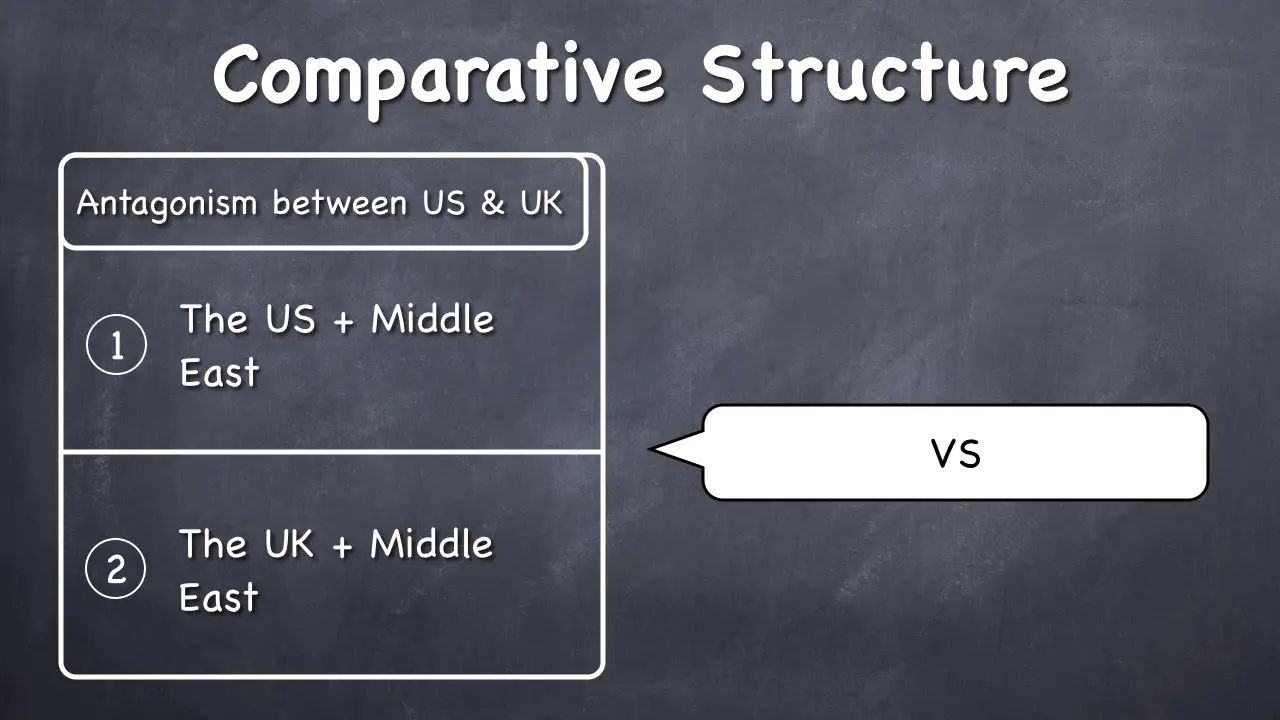
In this essay, we would simply have two sections.
In the first section, we would discuss everything that pertains to the United States and its Middle East oil policy.
And in the second section, we can discuss the United Kingdom’s oil policy in the region.
As a result, the similarities and differences between the oil policies of these countries will become apparent.
This is a very basic way to write a comparative historical essay. In a minute, I’ll show you a better, more advanced way to organize such a paper.
But now you have three simple and effective ways to structure your history essay. And it’s time to dig a level deeper and see how to organize content within the main sections of these structures.
How to Organize Your Ideas by Combining These Structures
Yes, I’ve saved the best for last. I’ve kept you in suspense a little. And that’s because we had to lay a solid foundation first.
Now that you know how to use chronology, themes, and comparison to structure your historical essay, you can simply combine these methods to create a complete outline.
By the way, if you need help with writing essays in general, I wrote this great tutorial for beginners.
Let’s look at the ways you can create a structure within a structure, using the methods you already know.
Combine Chronology with Themes
To use this combination, simply structure your essay chronologically first. And then use themes within each main section to create another level of organization.
This can really help you put every thought, every idea in place. Let’s see what the main structure would look like:
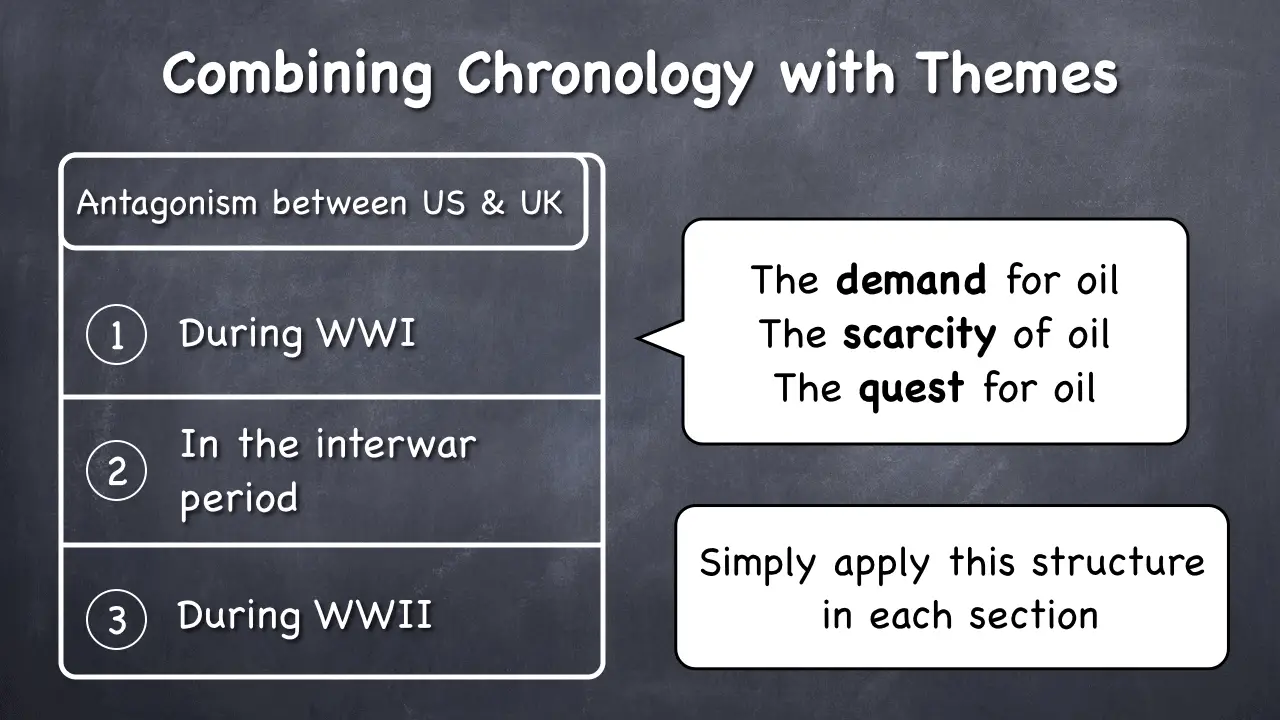
As you can see, we still have our three main sections arranged chronologically.
But now, within each of the sections, we also have a structure arranged by theme. Our three themes are the demand, the scarcity, and the quest for oil.
And all we need to do is have three little subsections in each section. Each subsection can have one or more paragraphs, depending on how big your paper needs to be.
Here’s what a complete outline of this essay might look like.
Sample History Essay Outline
- Introduction Paragraph
- Introductory sentence.
- Thesis statement.
- Antagonism between the US & the UK during WWI
- The demand for oil rose during WWI due to war machines
- Oil remained a scarce resource for a number of reasons
- The US and the UK competed for Middle Eastern drilling sites
- Antagonism between the US & the UK between the wars
- The demand for oil rose due to the auto industry
- Oil remained a scarce resource for a number of reasons
- The US and the UK continued to compete for Middle Eastern oil
- Antagonism between the US & the UK during WWII
- The demand for oil rose again during WWII due to war strategy
- Oil remained a scarce resource for a number of reasons
- The US and the UK raised the stakes in their quest for petroleum
- Conclusion
When you have this level of clarity about your essay, writing it becomes easy. It’s even easier when you do your math in terms of the number of words you need.
How to Meet Your Word Count Requirement
Let’s say that you need to write a 2,000-word essay. Here is how your basic math would work.
- Introduction Paragraph (100 words)
- Antagonism between the US & the UK during WWI (600 words)
- 200 words about the demand for oil
- 200 words about the scarcity of oil
- 200 words about the quest for oil
- Antagonism between the US & the UK between the wars (600 words)
- 200 words (demand)
- 200 words (scarcity)
- 200 words (quest)
- Antagonism between the US & the UK during WWII (600 words)
- 200 words (demand)
- 200 words (scarcity)
- 200 words (quest)
- Conclusion (100 words)
If you add up all the words, you get 2,000.
Your giant paper becomes a collection of smaller essays that you can easily handle, one by one.
Let’s explore the next way of combining structures.
Combine Themes with Chronology
This sounds the same, but is in fact different. In this case, your main structure is not chronological but thematic.
In other words, you arrange your main sections by theme, and then organize your subsections chronologically. Here is what this would look like:
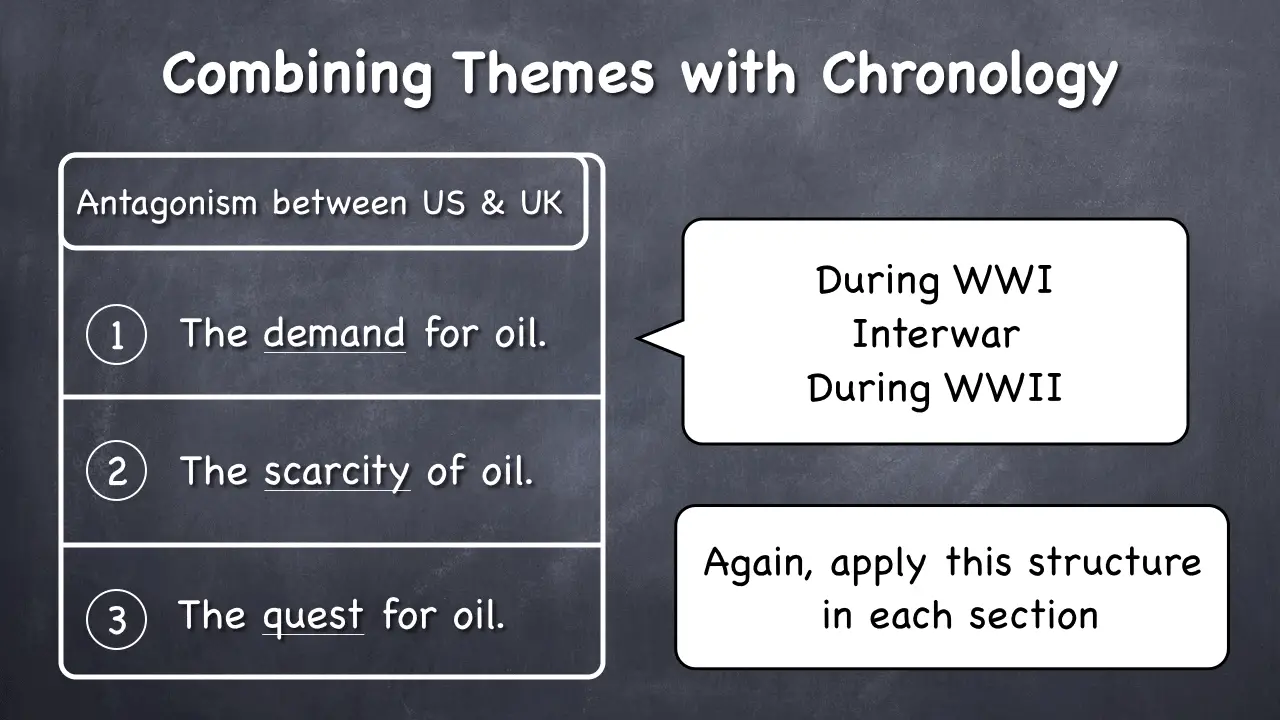
We basically switched Chronology and Themes around and made our thematic structure the main one, and the chronological the supporting one.
I don’t give you this option just to play with content. Instead, I want to make you see that you have many ways of organizing the same material.
Just pick a structure that you like and stick to it. Your material will often give you hints as to how you should organize your information and what structure would work best.
Now, as promised, I’ll give you the best way to organize your essay if you opt for a comparative structure.
The Best Comparative Structure for a History Essay
Earlier, I showed you how to divide a comparative essay into two main sections:

That way you can simply talk about one subject completely, and then talk about the other one completely. And that’s how comparison becomes apparent.
But it’s not the best way to do it for an important reason. You see, by the time your reader gets to the end of the first section, she has already forgotten what you were talking about in the beginning.
That’s because when you have only two sections, they are pretty long.
And now, as the reader goes through the second section, she has to keep referring back to the first section to see the similarities and differences.
This is why it is much better to structure your comparative essay either chronologically or thematically, and then use compare and contrast within subsections.
This way, you have three main sections instead of two. And it is much easier to see the similarities and differences when discussing them one next to another.
Let me illustrate.
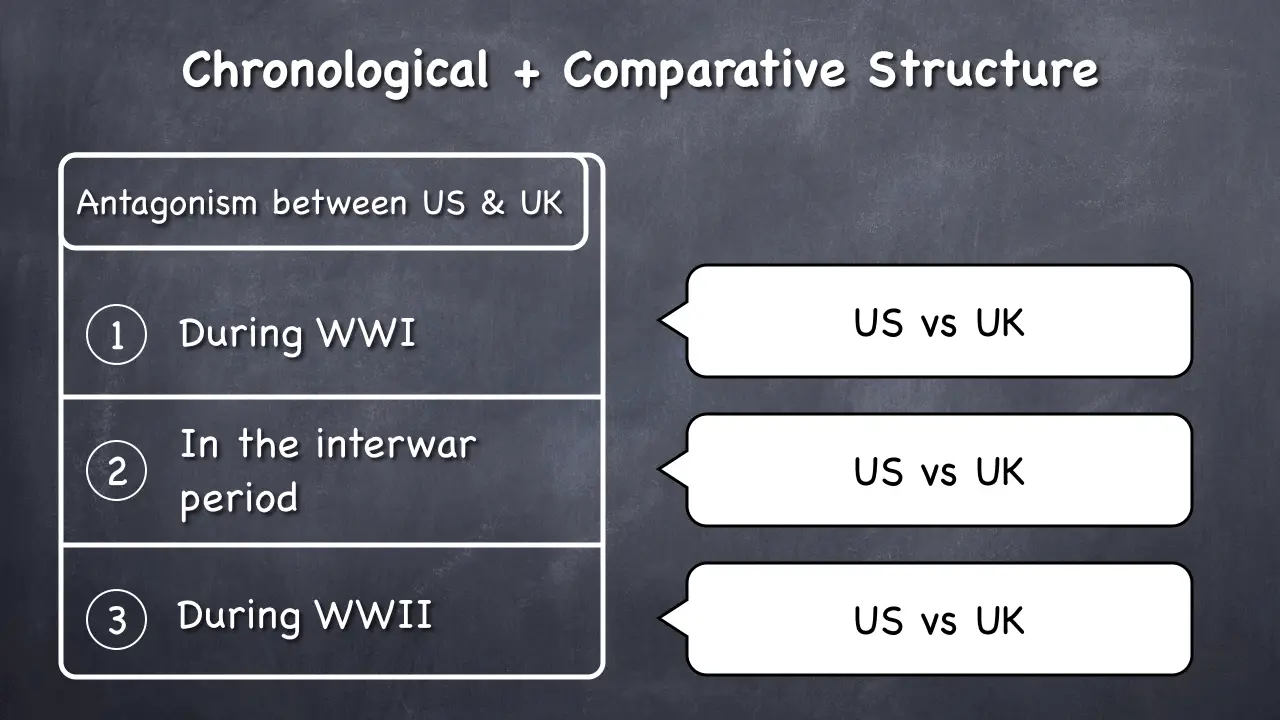
As you can see, in this structure, we arrange the main content chronologically. And we compare the US with the UK within each main section.
This is just much easier for a reader to digest. This is also easier to write because you as a writer have an easier time following your own comparisons.
Here is how you would use a thematic structure with comparison:
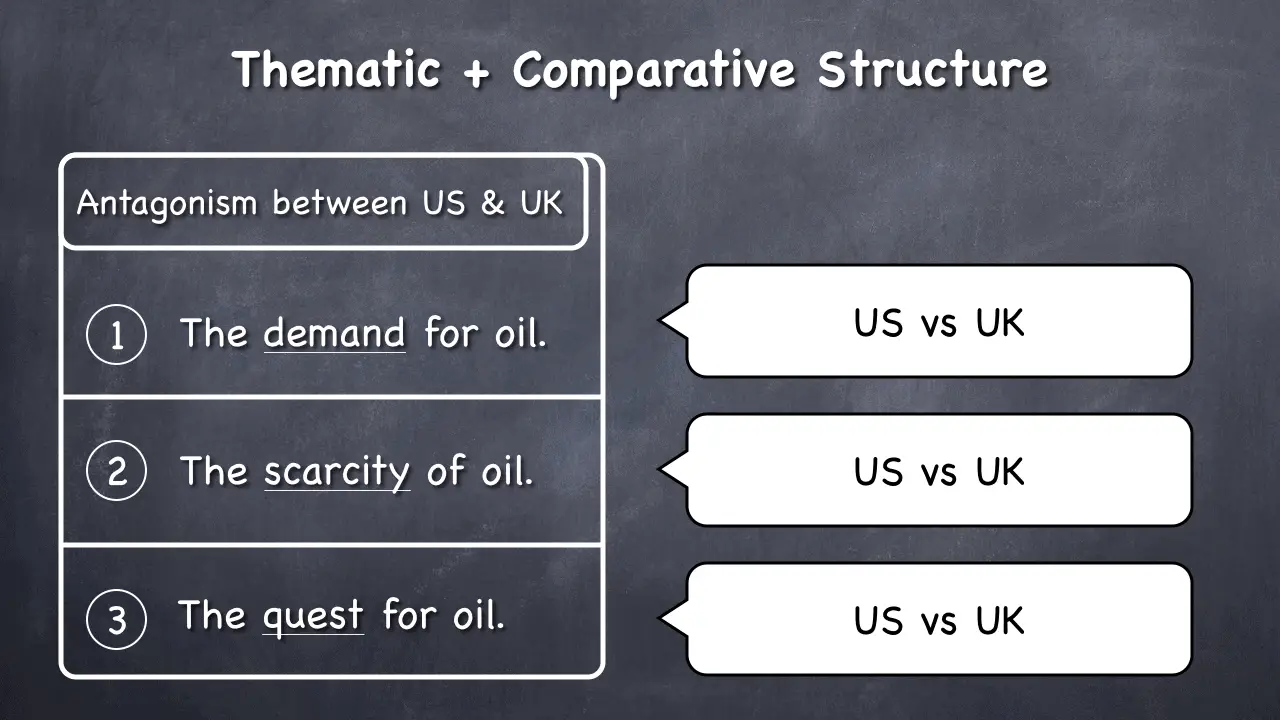
In this case, we again have three main sections, this time arranged by theme. And then we simply compare the US and the UK in whatever terms appropriate within each section.
I hope this guide was helpful.
If you’re a visual learner and would enjoy this lesson on video, here you are:
I also wrote a great tutorial on how to write a thesis statement that you might want to read next.
I wish you all the best with your history essay. Let me know how it went in the comments.
Tutor Phil
